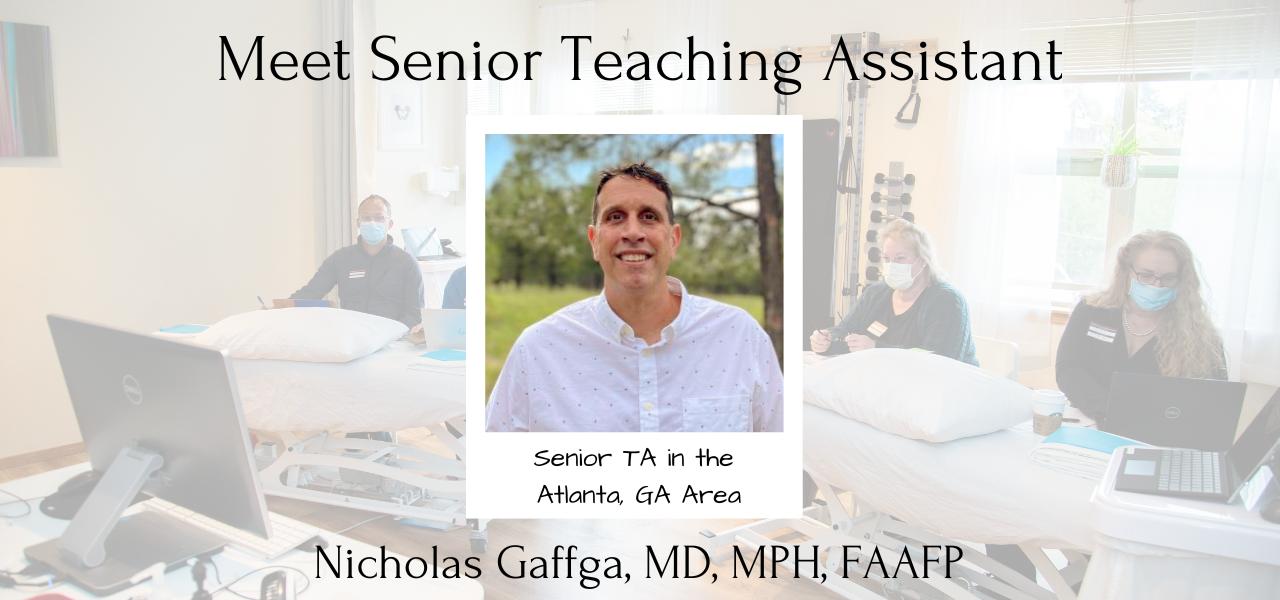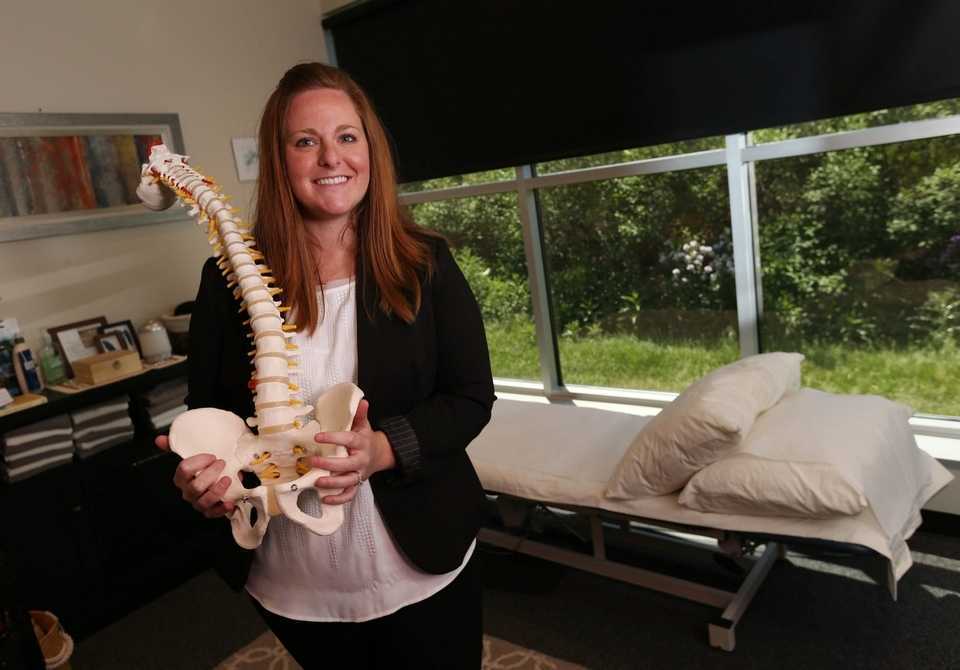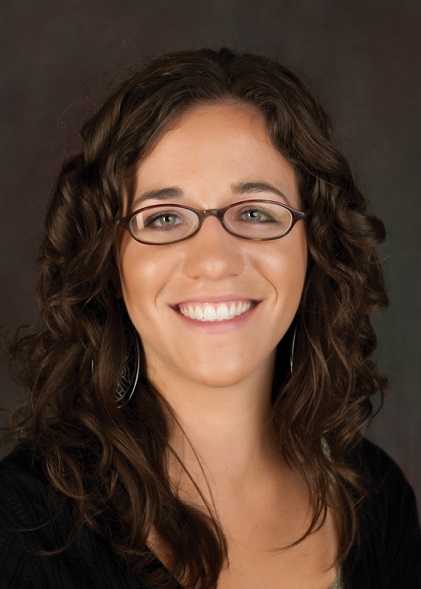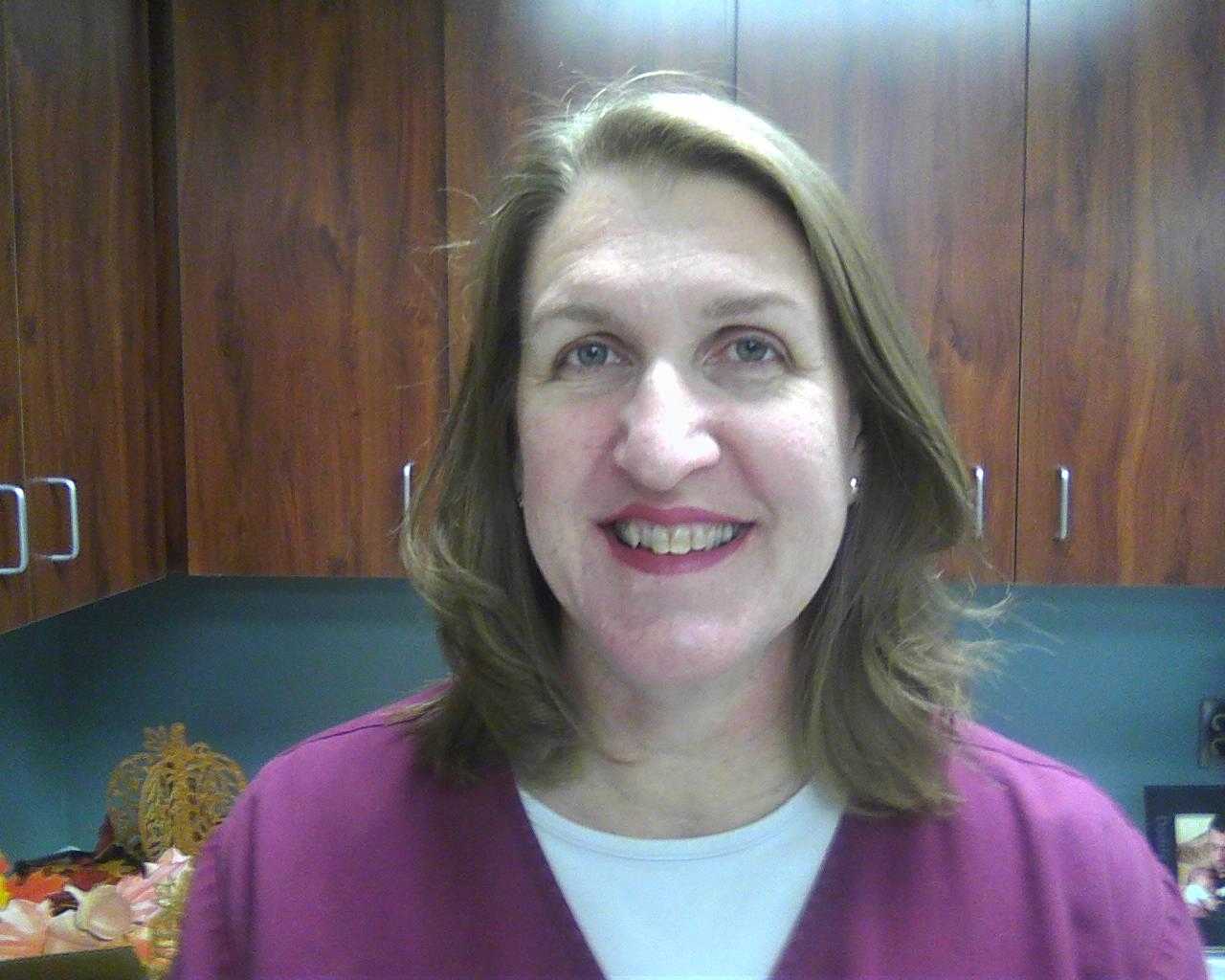
Maricel Briones, DPT, CMTPT, OCS sat down with The Pelvic Rehab Report this week to discuss herself and how she came to TA for Herman & Wallace. You can find Maricel this fall TA'ing Pelvic Floor Level 2B in Virginia Beach, VA.
Hi Maricel, can you share a little bit about yourself and your clinical practice?
Hi, I'm Maricel Briones, DPT, CMTPT, OCS and I've lived in Virginia Beach, VA my whole life. I graduated from Old Dominion University with a Bachelor in Exercise Science and followed that up with a Doctorate of Physical Therapy degree. I am now a Partner, Area Director, and Co-Leader of Pelvic Health with Ivy Rehab and have been a practicing therapist since 2012. I became an Orthopedic Clinical Specialist and Certified Myofascial Trigger Point Specialist for Dry Needling and recently became a Pelvic Health Therapist in 2020. My current clinic opened in December 2021, located in the Town Center area of Virginia Beach, VA. We are in the middle of expanding. We are a mix of outpatient orthopedic and pelvic health for men and women. My whole clinic is trained to support each other with all cases, even with pelvic health, and work together as a team for each patient's visit.
What has your educational journey as a pelvic rehab therapist looked like? Where did you start?
I started in early 2020 with Herman & Wallace (H&W) Pelvic Floor Level 1 in Virginia Beach, VA, then continued and took Pelvic Floor Level 2B towards the summer. It started a little slow because of Covid but it picked up in October 2022 and has been very busy since. In 2021, I continued taking more H&W courses including Pelvic Floor Level 2A, Male Pelvic Floor, and Pelvic Floor Capstone. I continued to host around 5-7 H&W courses to review the material and encourage local ortho therapists to join the pelvic health world. I eventually became a teaching assistant (TA) for H&W and have been loving it ever since. I became a Senior TA earlier this year.
How did you get involved in the pelvic rehabilitation field?
My regional director first asked and brought it to my attention, but I declined. A year later, she further explained the impact we can have for patients with pelvic floor conditions and got me convinced. I gave it a shot in 2020 and realized it was where I should be. It's the most rewarding type of treatment we can provide for a patient. We are helping a hidden population that we did not know exists right in front of us. Helping them with critical functions needed in life, voiding, BM, sex, etc.
What patient population do you find most rewarding in treating and why?
Either the pediatric or geriatric population for urinary incontinence (UI). I enjoy teaching them good bladder habits and how to properly contract their pelvic floor muscles. My first patient was an 80-year-old who had urinary incontinence for 20 years and after 1 week of pelvic therapy, she went from changing her pad around 8 times a day to only 2. I had my first pediatric patient who had seen 4 specialists in 1 year for UI. After 2 weeks of pelvic floor rehab, she went from having 4-6 accidents a day to 1-2 every other day.
If you could get a message out to physical therapists about pelvic rehab what would it be?
Don't be afraid of the "V". A lot of PTs are uninterested and do not realize how much pelvic floor muscle training is similar to orthopedic, either stretch it or strengthen it, and provide a lot of education on habits. Also, it's all about functional movement, so connect the pelvic floor with the upper and lower body for optimal outcomes. I did an internal Ivy Rehab Ted Talk in Florida for our Director's Summit in May 2021, titled "Don't be afraid of the 'V'". What you're nervous of or afraid of, may actually be where you are meant to be or do.
What lesson have you learned in a course, from an instructor, or from a colleague or mentor that has stayed with you?
Continue to learn no matter what, and never settle. My treatment programs and assessments evolve every year because of continued learning and advice from colleagues. Always be open to different approaches and be patient with all complex cases.
What do you find is the most useful resource for your practice?
Facebook groups such as Global Pelvic Physio (run by Michelle Lyons), Pelvic PT Newbies (run by Jessica and Andrew Reale), Pelvic PT Huddle (run by PelvicSanity and Nicole Cozean), and Pelvic Floor Biofeedback (run by Tiffany Ellsworth Lee) have been my go-to for learning about cases, ideas, etc.
What is in store for you in the future as a clinician?
I plan to take the PRPC exam soon for board certification. I am also working with Ivy Rehab to create a year-long Pelvic Health Specialization program.
What has been your favorite Herman & Wallace Course and why?
Pelvic Floor Level 2B, since I learned more in-depth manual therapy for the pelvic floor and it helped nail down the anatomy of the pelvic region. I also love the manual therapy skills that we learned in Capstone.
What lesson have you learned from a Herman & Wallace instructor that has stayed with you?
Lengthen before strengthen!
What do you love about assisting at courses?
It's an information refresher. The more you hear it, the more it sticks. I also love teaching the students the concepts and anatomy that were originally confusing for me.
What is your message to course participants who are just starting their journey?
Continue to take more courses on pelvic floor rehab as there are so many different pelvic health conditions. Take the same concepts you learned about muscle training for any body part and apply them to the pelvic region. Connect the pelvic region to the whole body and focus on actively training it with function. It's not just about motor control of the pelvic floor muscles, it's coordinating it with the abdominals, hips, back, etc. Not all visits are hands-on one-on one-on-one. If you create a robust well-rounded program for them and they will progress quicker than you expect.
Today we are honored to present our featured Certified Pelvic Rehabilitation Practitioner Jessica Dorrington, PT, MPT, OCS, PRPC, CMPT, CSCS! Jessica was kind enough to answer a few questions about her role in pelvic rehab.
Describe your clinical practice:
Our clinic practice is an outpatient orthopedic private practice. We are committed to making individual results accessible through compassionate therapeutic care. Our practice spans treating men, women and children through a realm of urologic, gynecologic, obstetric, and colorectal conditions- as well as orthopedic conditions.
 How did you get involved in the pelvic rehabilitation field?
How did you get involved in the pelvic rehabilitation field?
Initially, I was an outpatient orthopedic physical therapist. Within the first few months of my career, the clinic I was working at needed someone to just “teach Kegel exercises”. When I realized the impact that you could have on someone’s life, I was immediately drawn to the pelvic rehabilitation field. I saw getting someone even 75 percent improvement was a whole different success than getting a shoulder patient 75 percent better that could now throw their ball to their dog. It was restoring relationships, saving marriages, and giving women the freedom to go do things they could not do before.
What/who inspired you to become involved in pelvic rehabilitation?
My patients inspire me every day. I initially started treating incontinence patients and then gradually added chronic pain patients to my case load. Each patient that achieved such success with pelvic rehabilitation inspired me to wanting to learn more and reach out to more patient’s in need of physical therapy. This led me into treating men and children with pelvic rehabilitation issues. My favorite story that initially started me on my career path was a 95 year old women who came to me for low back pain. I asked her if she had any incontinence. After 4 visits, she removed a pessary (that she had for the past 55 years-since the birth of her last child) and was painfree and fully continent!
What patient population do you find most rewarding in treating and why?
My favorite patients are those that have seen every specialist and have complex histories. Being able to really listen to their story and give them answers in a health care setting that has not found a solution to their condition is such a wonderful experience. Our professional affords us such a great opportunity to really get to know these patients, dive deep into their history and put the puzzle pieces together for them in a way most professions do not have time for in our current medical model.
If you could get a message out to physical therapists about pelvic rehabilitation what would it be?
As I have grown as a practitioner over the years, the biggest message I have is to really listen to each story. Even a simple SI joint dysfunction patient or a seemingly straight forward stress incontinence patient can have subjective and objective information that really points to the root of the issue. We can really serve these patients the best and premier care if we are up to date on our dermatologic, hormonal influences, musculoskeletal system, and are strong orthopedic clinicians.
What has been your favorite Herman & Wallace Course and why?
Michelle Lyons Athlete and the Pelvic Floor course was wonderful. Michelle is a gifted facilitator of education, has so many pearls of valuable resources and tidbits. She also does a wonderful job combining the orthopedic and pelvic floor world together.
What lesson have you learned from a Herman & Wallace instructor that has stayed with you?
Holly has been truly inspirational to me as she is so passionate about her career and passionate about our profession. Her education on hormones really helps me to sort out for patients when I feel there is a hormonal influence.
What do you find is the most useful resource for your practice?
A pelvic model and Adrian Louw’s Explanation of Pain/Neuroscience education has been such a great resource. For most pelvic pain patient’s there is some sort of sensitive nervous system overlie and the way he educates patients has been lifechanging. The other strong resource has been motivational interviewing education. This allows to really guide these patients in a way that assesses their readiness and motivation for change. The other resource is using the rehabilitative ultrasound imaging. Jackie Whittaker has been such a wonderful mentor to me and this resource has revolutionized the way that I treat diastasis patients, local stabilization, and men and pediatric populations.
What motivated you to earn PRPC?
I am doing more speaking engagements to other medical providers and am doing a lot of mentorship. Being in these roles, I feel having credentials to back the clinical experience is really valuable.
What makes you the most proud to have earned PRPC?
I took the exam without studying, largely because I wanted to see if my skills and knowledge was antiquated (being I have been doing pelvic floor therapy x 14 years). I found the test to be really fun and challenging in an exciting way. The case studies were true examples of the complex patients we treat and so I enjoyed the process.
What advice would you give to physical therapists interested in earning PRPC?
My advice would be to really do some great critical reasoning around your current patients. We learn best by our patients and doing a practice of critically thinking and differential diagnosis around your current patients will give a platform for this. I recalled treating several patients during the examination and could picture very similar patient presentations. The other piece I would recommend is reviewing your anatomy and pharmacology.
What is in store for you in the future?
I am continually blessed to be able to lead a wonderful team of therapists at our outpatient private practice. We are launching a labor and delivery program and post-partum evaluations. Educating the medical community at large has been a focus of mine and I would like to continue to do so to get the word out about pelvic floor PT. I have been asked to speak at the United Nations next Spring and will be presenting about Pelvic Floor in relation to Motherhood Maternity. Mentorship to pelvic floor therapists and students also continues to be a focus.
What role do you see pelvic health playing in general well-being?
I strongly feel pelvic health therapists could play a role in every orthopedic patient’s care. We have so many tools to really evaluate patients from a full body spectrum and have the ability to address any lumbopelvic condition with true depth. Having this vital information about their bodies can really empower all individuals to return to what they love to do in an active healthy lifestyle!
Congratulations to Dr. Sarah Capodagli, DPT, our featured practitioner of the week! Dr. Capodagli owns and operates CorrEra Physical Therapy, and she is in the process of expanding her practice in Buffalo, NY. We were curious to hear more from her about running a practice in Buffalo, and Sarah was kind enough to write in. Thanks, Sarah!
 Although Buffalo is considered the second largest city in the state of New York, we often operate like a small town. We value community and for just about any business, the best marketing tool is word of mouth. If you need a new roof, new car, or a good doctor, well, ask around and I guarantee that you will find someone who “knows a guy,” to help or advise. I cannot speak for every city, though when I think of Buffalo, NY, I think of family. When you see your family in need, you help.
Although Buffalo is considered the second largest city in the state of New York, we often operate like a small town. We value community and for just about any business, the best marketing tool is word of mouth. If you need a new roof, new car, or a good doctor, well, ask around and I guarantee that you will find someone who “knows a guy,” to help or advise. I cannot speak for every city, though when I think of Buffalo, NY, I think of family. When you see your family in need, you help.
A few years ago I was working in a large oncology hospital and one of my primary roles was running the pelvic floor rehabilitation program for men living with or being treated for prostate cancer. I loved this work; however, I saw greater need in our community for not only the proper conservative care and treatment, but also for the information about pelvic health to be shared more publicly with men and women. Although opening my own clinic in a suburb of this “City of Good Neighbors” was not always the plan, when given the opportunity to grow into my own practice by a chiropractor friend, I jumped at the chance and have never looked back. It was a big jump, but for me, the fear of regret in never trying was so much worse than the fear of failure.
The greatest challenge was in actually starting my practice and beginning to educate the community and physicians. In a larger metropolis there is more awareness of this specialty and referrals come more naturally when conservative options are made known to patients. In the beginning I reached out to a mentor, utilized many tools available on the Herman & Wallace website, held free community events, and spent my first few months focused on networking. Once introduced to some fabulously conservative docs, birthing professionals, and physical therapists who were aware of the benefits of pelvic floor rehab, I really started to see the growth. I became an advocate for patients – a navigator in this sometimes confusing and frustrating system. People want conservative options and when happy patients return to their physicians with improved symptoms and quality of life, well, now your reputation establishes you as one of the “go-to” practitioners in the community.
Though patience and persistence are crucial in this process of growth, I’m also a firm believer that, as Dr. Francis Peabody stated, “the secret of the care of the patient is in caring for the patient.” This belief is what sets me apart, and in a small community this is what really matters. One of my favorite books is The Go-Giver by Bob Burg and John D. Mann. I always want my practice and the growth of my business to reflect the strategies of value, service, influence, and authenticity emphasized in this story. In a community where community is valued, I truly believe that if you stay teachable and positive, the care you put into your practice will always pay off.
Kelley Thibault PT, NCS is an outpatient rehabilitation pro, having more than two decades of experience in that setting. She is a recent convert to Pelvic Rehabilitation, however, and she's jumped in head first! Her practice has shifted in that direction and she has four Herman & Wallace courses under her belt in just the last two years. We reached out to see what lessons she could share with us, and she was kind enough to give us her time today. Welcome to the field, Kelley!

Tell us a bit about your clinical experience:
I have been a physical therapist for 22 years and spent much of my career working in a hospital based outpatient clinic treating primarily neurologic diagnoses. I have worked in a transdisciplinary neurologic program for much of this time. I received my NCS from the APTA in 2004 and recertified in 2014. Over my career I have had an interest in Women’s Health Physical Therapy and attended a course with Holly Herman in the early 1990’s. I began treating more Women’s Health clients about 2 years ago to cover a maternity leave. 75% of my practice now is Women's and Men’s Health. I attended the pelvic floor level 1, 2A, 2B and 3 courses over the past year and have found them to be invaluable!!! I also have taken many of the pelvic courses on MedBridge.
What/who inspired you to become involved in pelvic rehabilitation?
I find it most rewarding to work with women who are postmenopausal and are experiencing dyspareunia and stress and/ or urge incontinence. I find with some education and behavioral modifications these clients can experience gains after the first visit. I also have enjoyed working with the chronic pelvic pain clients who require internal pelvic floor and myofascial work and seeing them return to function with less pain and more confidence.
What has been your favorite Herman & Wallace Course and why?
Pelvic floor rehabilitation works!!! There is so much that can be preventative as well as rehabilitative. I look forward to learning more and more!!! I think my favorite course thus far has been 2A mainly due to the fact that was the last course in the series that I took this past December 2015. The information on constipation and fecal incontinence as well as male pelvic anatomy, physiology and treatment was the piece I so felt I was missing in helping my clients.
What lesson have you learned from a Herman & Wallace instructor that has stayed with you?
I have found the “clinical pearls” given in each course to be invaluable!!! I have reviewed my manuals several times and will continue to do so.
What is in store for you in the future?
I hope to obtain my PRPC or WCS in the next several years and plan to continue to attend courses to improve my practice. I have been able to use my knowledge of pelvic health and treatment with my neurologic clients as well.
This week we end with a fantastic interview with our featured pelvic rehab practitioner. Nancy Suarez, MS, PT, BCB-PMD, PRPC just joined the ranks of the elite Certified Pelvic Rehabilitation Practitioners! Check out our interview below:
 Describe your clinical practice:
Describe your clinical practice:
I work in a private practice specializing in women’s and men’s pelvic floor disorders including bowel and bladder issues, prolapse and sexual dysfunction, prenatal and postpartum rehabilitation, pre and postprostatectomy care, and lumbopelvic pain.
How did you get involved in the pelvic rehabilitation field?
As a physical therapist who regularly took continuing education courses following PT school, I happened to be looking for a course that might give me more knowledge to help some of my geriatric patients improve their urinary incontinence. I took my first Pelvic Floor course given by Hollis Herman and Kathe Wallace in 2000, and immediately began to make a difference in many of my patient’s lives.
What/who inspired you to become involved in pelvic rehabilitation?
Really it was my patients that inspired me to become involved in pelvic floor rehabilitation; I knew embarassingly little about it on my own until my first course! I was very fortunate to have been given the opportunity to join a pelvic floor specialty practice a few years after that first course, and there I honed my skills and began adding more pelvic floor courses to improve my practice.
What patient population do you find most rewarding in treating and why?
It is honestly difficult for me to choose one type of patient that I find MOST rewarding; it is such a privilege to see patients getting better when they may have thought there was no hope. I do find that I love helping middle aged and older women learn about their pelvic floor and learn how to overcome their incontinence, prolapse and pain.
Happy Tuesday! Today we are fortunate enough to hear from Stefanie Foster, who just earned her designation as a Certified Pelvic Rehabilitation Practitioner! Thank you for your time, Stefanie, and congratulations!
Describe your clinical practice:
I have a private practice specializing in pelvic health and related orthopedic conditions. My clinical practice is infused with my training in yoga, pelvic rehab, women’s functional nutrition, orthopedic manual physical therapy, and movement system impairment syndromes.
 How did you get involved in the pelvic rehabilitation field?
How did you get involved in the pelvic rehabilitation field?
I first became curious about the pelvic floor muscles as a consequence of treating orthopedic conditions. No matter what you’re working with in that setting– back pain, hip pain, even shoulder or foot, central stability or the core is of utmost importance. I started to wonder what was going on with the respiratory diaphragm and pelvic floor when we were doing all this abdominal bracing that was (and still is in some circles) all the rage. I arranged a clinical in-service with Susan Steffes to come give us a little overview and talk about how to screen for when someone needed to see a pelvic PT. After that little hour, my interest was piqued and I knew I had to learn more…hence my first H&W class.
What/who inspired you to become involved in pelvic rehabilitation?
It was a gradual inspiration, beginning with Susan. Then, I would have to say Holly and Kathe; my experience in Level 1 forever changed my professional trajectory. As far as the “what”, clinically I am always very attracted to the zebras, the complex conditions, the things that are slipping through the cracks in the medical system, the underserved…and everything about pelvic rehabilitation is that. It’s also a big public health...uh I’ll say opportunity rather than crisis. As a profession, we are doing better, but we still have a long way to go before everyone knows what we can do. Imagine how many people we could help if EVERYONE knew?! It’s really exciting!!
What patient population do you find most rewarding in treating and why?
I love working with patients who come in with a student’s mind. The ones who are curious, ask questions, take notes, and consistently do their homework typically develop a great working relationship with me and have excellent outcomes.
If you could get a message out to physical therapists about pelvic rehabilitation what would it be?
To my former orthopedic-focus-only self and anyone in the same boat, it would be to stop pretending the pelvic floor doesn’t matter in your practice. At the very least, when you’re doing your red flag screen and ask if the patient has had any changes in bowel or bladder, stop downplaying it when the patient mentions they have had some minor leaks or constipation. Refer them to a pelvic rehab specialist! Don’t scare them, just tell them it’s common and there’s pharma-free help out there!
What has been your favorite Herman & Wallace Course and why?
Holly and Kathe taught my Level 1 and it was one of THE BEST courses I’ve ever taken (I’m not just saying that because it’s for their site!). They somehow managed to simultaneously have us rolling on the floor laughing, feeling incredibly supported and comfortable, and leave us ready to walk out the door and treat patients Monday morning. Incredible.
What is in store for you in the future?
More teaching and research. I am passionately curious about several unanswered questions and could keep myself busy the rest of my life investigating and sharing my findings. Right now, the relationship of orthopedic conditions and movement impairments of the hip with pelvic floor-related complaints has mesmerized me!
What role do you see pelvic health playing in general well-being?
If you look at the yoga tradition, the pelvic floor is our base, our ground, our safety, our manifestation into the world… Everything we work with - bladder, bowel, sexual function, birth – is so basic to life on earth! Treatment of these conditions is truly life enhancing! Without the pelvic floor and related structures functioning optimally, it’s challenging to get the rest of the system to function optimally.
 This week we are proud to feature Christy Ciesla, PT, DPT, PRPC! She just earned her Pelvic Rehabilitation Practitioner Certification, and was kind enough to share some of her thoughts with the Pelvic Rehab Report. You can read the interview below. Congratulations to Christy and all the other PRPC practitioners!
This week we are proud to feature Christy Ciesla, PT, DPT, PRPC! She just earned her Pelvic Rehabilitation Practitioner Certification, and was kind enough to share some of her thoughts with the Pelvic Rehab Report. You can read the interview below. Congratulations to Christy and all the other PRPC practitioners!
Tell us about your clinical practice:
I am currently coordinating a Women and Men’s Health program at the Miriam Hospital (The Men’s Health Center and The Women’s Medicine Collaborative) in Rhode Island. We are fortunate to be a team of 5 skilled pelvic therapists and to work with the some of the best physicians and surgeons in New England. We work with so many different patients. I am currently most excited about our involvement in a tremendous Cancer Survivorship Program offered here at the Women’s Medicine Collaborative.
How did you get involved in Pelvic Rehab?
I have always been actively involved in women’s issues, even as a college student, helping with programming for the Women’s Resource Center on campus. After I had my first son in 2003, I became very interested in working with pregnant and postpartum women, and the pelvic rehab involvement took off from there. I was sent my first male patient in 2008, and found that I enjoyed working with men just as much as working with women in this area.
What/who inspired you to become involved in pelvic rehabilitation?
I went to Elizabeth Noble’s OB/Gyn and Prenatal Exercise Courses in 2004. During the course, we talked quite a bit about birth and the pelvic floor. I left there fascinated with the field, and took my first pelvic floor course a couple of years later.
What patient population do you find most rewarding in treating and why?
I love treating all of my patients, but perhaps the most rewarding feeling is when I can help a cancer survivor SURVIVE their cancer. All too often, when the treatment ends, the patient is left to feel alone with all of the effects of chemo, radiation and surgical trauma. They have incontinence, pelvic pain, and sexual dysfunction, and feel lost. Being able to offer a light in the darkness to these people is the greatest gift that pelvic rehabilitation has given me.
If you could get a message out to physical therapists about pelvic rehabilitation what would it be?
You will never have more of a rewarding experience than you will when you help your patients pee, poop and have sex without dysfunction. I mean, really….what else is there to life?!
What has been your favorite Herman & Wallace Course and why?
PF 1 has still got to be my favorite. It was the most packed with great info, Holly was my instructor, and I was first introduced to the magical world of pelvic rehabilitation. I will never forget that experience.
What lesson have you learned from a Herman & Wallace instructor that has stayed with you?
One of the things that has been consistently conveyed in all of my courses with H&W is the importance of caring for, respecting, and honoring our patients for having the bravery to address these sensitive issues, and to share them with us. The coursework prepared me with the knowledge I needed to help my patients, but the amazing instructors also helped me be a better provider in other ways.
What motivated you to earn PRPC?
So far, I have taken 7 Herman and Wallace courses (8 including the PF 1 course that Holly did privately for my facility and I was able to assist with). It just seemed right to be certified through this wonderful institute. It is what I do every day, all day, and I felt that I needed these credentials to go further with my career in this field.
We're excited to have the chance to interview Lisa Odabachian, MPT, BSN, RN, PRPC, this week's featured Certified Pelvic Rehabilitation Practitioner! Lisa earned her certification in May of 2015 and she was kind enough to share her thoughts with us. Thank you for your contributions to the field of pelvic rehab, Lisa, and congratulations on your certification!

What motivated you to earn PRPC?
For patients and referring providers to have confidence that I have expertise in treating pelvic floor dysfunctions.
What makes you the most proud to have earned PRPC?
That I have evolved into a practitioner that can make a difference in this patient population’s quality of life.
What advice would you give to physical therapists interested in earning PRPC?
Take as many courses with hands on lab work that you can so you can treat with a broad base of knowledge to get the best outcome for your patients!
Tell us a little about your clinical practice:
I am a full-time clinician at a well-known and well-respected hospital-based outpatient women's clinic. I have been at the Beaumont's Women's Urology Center, a multidisciplinary clinic focusing exclusively on women's health, for the past 5 years. incontinence, pelvic organ prolapse, urinary urgency and frequency, chronic pelvic pain conditions (painful intercourse, interstitial cystitis, vulvodynia, abdominal pain), post-surgical pain and weakness, colo-rectal dysfunctions (fecal incontinence, constipation, rectal pain). I have been in clinical practice treating women and men with pelvic dysfunctions for over 14 years at Beaumont Hospital. Prior to that I was a clinical nurse treating patients in a variety of settings. I am currently an ABPTS candidate to sit for the 2016 WCS specialist certification examination in Women's Health physical therapy.
How did you get involved in the pelvic rehabilitation field?
Through the years of being a nurse, family member and friend I have heard many stories from women and men who have had symptoms that were unsuccessfully or only partially helped with medications and/or surgical interventions. When I learned that there were specially trained physical therapists who treat bladder, bowel and sexual problems by providing the patients self-help education and rehabilitation techniques to help resolve these issues, I became charged up to get my master’s in physical therapy so I could then specialize in treating pelvic floor dysfunctions.
What/who inspired you to become involved in pelvic rehabilitation?
When I learned that there were specially trained physical therapists who treat bladder, bowel and sexual problems by providing the patients self-help education and rehabilitation techniques to help resolve these issues, I became charged up to get my master’s in physical therapy so I could then specialize in treating pelvic floor dysfunctions.
What patient population do you find most rewarding in treating and why?
The patients who are motivated in helping themselves by being compliant in their rehabilitation by doing their home exercise program and asking questions are the patients who typically have the best outcomes.
If you could get a message out to physical therapists about pelvic rehabilitation what would it be?
There are so many women and men who could benefit from a skilled pelvic floor physical therapist. Many patients with pelvic floor dysfunction have difficulty being appropriately evaluated and referred to pelvic floor physical therapy, and then if that occurs they often have to travel long distances to find a proficient provider.
What has been your favorite Herman & Wallace Course and why?
I have learned so much from each and every course I have taken. My first course was in Akron Ohio in May 2001 with Holly Herman and Kathe Wallace, so of course that is my most memorable course because it was like opening a Pandora’s Box, in a good way! It all made sense!
What lesson have you learned from a Herman & Wallace instructor that has stayed with you?
Perform a good orthopedic evaluation first
What do you find is the most useful resource for your practice?
I often refer to course/lab course notes.
What is in store for you in the future?
My application has been approved to sit for the 2016 specialist certification examination in Women’s Health in physical therapy to obtain WCS credentials through the APTA.
What role do you see pelvic health playing in general well-being?
It’s huge! When people have bladder, bowel and/or sexual dysfunction, their relationships, social, career, education, emotional, recreational and/or psychological, etc. well-being is affected to varying degrees. People often do not even know they have pelvic floor muscles until there is pain or a functional impairment.
This week we get to feature Katie Tredo, DPT, PRPC, one of the first people to earn her Pelvic Rehabilitation Practitioner Certification! Katie co-owned a private practice in Maryland, and has recently relocated to the Milwaukee area to practice her trade. She was kind of enough to offer her insights with the Pelvic Rehab Report today.
![]() Hi Katie! Tell us a little bit about your clinical practice
Hi Katie! Tell us a little bit about your clinical practice
I recently joined the staff at Health In Balance Physical Therapy in Mequon, WI. Our team is made up of experienced physical therapists with a variety of interests and specialties. Along with two of my coworkers, my practice is focused on treating men, women, and children with pelvic dysfunctions. I think a practice with such a skilled and diverse set of physical therapists allows us to better serve our patients.
What patient population do you find most rewarding in treating and why?
I find treating patients with pelvic dysfunctions, especially pelvic pain, to be extremely rewarding. Pain, incontinence, and other pelvic dysfunctions can leave patients feeling very isolated and hopeless. Watching my patients open up about their issues then progress toward their goals, returning to their previous activities and relationships without pain or dysfunction is amazing. There are so many quality of life issues that go along with pelvic dysfunctions and I am honored to be a part of each of my patient’s journey to recovery.
If you could get a message out to physical therapists about pelvic rehabilitation what would it be?
I would encourage physical therapists to get comfortable asking about bowel, bladder, and sexual dysfunction on their initial intake forms. Many people will not think to report these issues without being asked and a pelvic dysfunction can be a major component of a hip or back issue. If your patient reports a pelvic dysfunction, be comfortable acknowledging it and make an appropriate referral for them. I enjoy working closely with and sharing patients with other physical therapists so that we can maximize our patients’ recovery.
What role do you see pelvic health playing in general well being?
In the past discussing pelvic dysfunctions was considered embarrassing or taboo. In the past few years, I have seen more and more of my patients educating themselves, discussing their issues with other men or women, and finding themselves the help they need. Many patients are going into their referring physicians and requesting to receive help instead of waiting for their doctor’s suggestion. Patients are becoming more empowered over their own care. I see pelvic health becoming more and more of a focus in people’s lives and that fewer patients will be content living with their dysfunction.
 Today we are so fortunate to hear from Diane Hubbard, PT, who is this week's Featured Pelvic Rehab Practitioner! Diane has completed the full Pelvic Floor Series and puts her skills to use every day. Thank you, Diane for your contributions to the field of pelvic rehabilitation, and for sharing your thoughts with us!
Today we are so fortunate to hear from Diane Hubbard, PT, who is this week's Featured Pelvic Rehab Practitioner! Diane has completed the full Pelvic Floor Series and puts her skills to use every day. Thank you, Diane for your contributions to the field of pelvic rehabilitation, and for sharing your thoughts with us!
Tell us about your clinical practice
I am working in inpatient rehabilitation. However, I am increasing my time in pelvic rehab, as the caseload increases, in an outpatient rehab setting.
How did you get involved in the pelvic rehabilitation field?
Our hospital system was negotiating with a urology group of physicians to come and serve in our area. One of the requests of the urology group was that the hospital have a pelvic floor trained physical therapist to work with their patients as needed. Our rehab director asked if any of the PTs were interested in working with a urinary incontinence program. I said that I was very interested and was eventually given the opportunity to become trained to work with pelvic floor patients.
I will admit that I had no idea how involved the training would actually be! I really had to contemplate if I was willing to commit to all areas of the training, most especially internal exams. I finally realized that if I was not willing to learn to do internal exams, it would be like trying to perform gait training on someone if I had never seen them walk. I would be doing my patients a disservice if I was not willing to learn to do internal exams. Then I thought, when you go to a gynecologist, you know what to expect and it is fine since they are helping you. So, that is how I looked at it for pelvic floor patients.
It was worth all of the training the first time that my pelvic floor patient said to me that she was so glad that I got trained in this since no one else has been able to help her!
What/who inspired you to become involved in pelvic rehabilitation?
I was working in a SNF and I got a referral from the DON regarding a patient with incontinence. I did not know much about kegels but said that I would try. The patient said that for 40 years, she had used a pad an hour for incontinence of urine but that she was willing to try. We did 15 minutes of kegels 3 x week, then she eventually got down to 3 pads in a 24 hour period for incontinence. We were all surprised and pleased with the results!. That piqued my interest in pelvic rehabilitation.
What patient population do you find most rewarding in treating and why?
I really enjoy helping people who are willing to work hard to help themselves. It is so awesome to see them understand the concepts and perform the exercises and continue them on their own. It is inspirational to see them improve the quality of their own lives!!!
What lesson have you learned from a Herman & Wallace instructor that has stayed with you?
No ?JICING? (just in case) from Holly Herman, as she stood with her hands out and repeated that phrase several times. My co-workers now understand that phrase too!
What is in store for you in the future?
There were no other pelvic floor therapists in my geographic area when I started this training. I had to travel and was mentored by a few pelvic floor therapists who let me observe and shared some paperwork with me. I was glad to learn from the many helpful and experienced people that I met in the H&W education classes. I got my first patient in the same month that I completed the last of the 4 classes in the H&W pelvic floor series. My first patient was coccydynia and the second patient that I had was a male. I was so grateful that I had taken all 4 classes in the series before I started treating or else I would not have had experience in knowing what to do to help those first 2 patients! I am learning as I go, that is for sure! I had to start this program from the ground up, using the resources that I had available. I have been able to secure handouts, learn g-codes, formulate documentation forms and do some marketing. I have been lucky enough to be able to increase my caseload almost every month this year. It is so worth it as I have heard more than 1 patient tell me that they can do this program and that I have given them some hope!














































